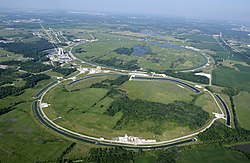41°49′55″N 88°15′26″W / 41.83194°N 88.25722°W


Fermi National Accelerator Laboratory (Fermilab), located in Batavia near Chicago, Illinois, (Google Sat Map) is a U.S. Department of Energy national laboratory specializing in high-energy particle physics, operated for the Department of Energy by the Universities Research Association (URA). URA is a consortium of 90 leading research oriented universities primarily in the United States, with members also in Canada, Japan, and Italy. It is a part of the Illinois Technology and Research Corridor.
Fermilab's Tevatron is a landmark particle accelerator; in fact, at four miles in circumference, it is the world's highest energy particle accelerator. In 1995, both the CDF and D0 (detectors which utilize the Tevatron) experiments announced the discovery of the top quark. In addition to high energy collider physics, Fermilab is also host to a number of smaller fixed target experiments and neutrino experiments, such as MiniBooNE (the Mini Booster Neutrino Experiment) and the NuMI (Neutrinos at the Main Injector) /MINOS (Main Injector Neutrino Oscillation Search) experiment. The MiniBooNE detector is a 40-foot (12-meter) diameter sphere which contains 800 tons of mineral oil lined with 1520 individual phototube detectors. An estimated 1 million neutrino events are recorded each year. The NuMI/MINOS experiment uses a particle accelerator at Fermilab to produce an intense beam of neutrinos that travels 450 miles through the Earth to the Soudan Mine in Minnesota.
In the public realm, Fermilab is host to many cultural events, not only public science lectures and symposiums, but classical and contemporary music concerts and arts galleries, when the Homeland Security Advisory System permits. Currently the site is open to all visitors from dawn to dusk who present valid photo identification.
A small herd of American bison [1], started at the lab's founding, lives on the grounds symbolizing Fermilab's presence on the frontier of physics and its connection to the American prairie.
Asteroid 11998 Fermilab is named in honor of the laboratory.
The village of Weston voted to dissolve itself to become the grounds of Fermilab.
History
Founded in 1967 as the National Accelerator Laboratory, it was renamed in honor of Enrico Fermi in 1974.
The lab's first director was Robert Rathbun Wilson, a gifted physicist and artist. Many of the unique sculptures on the site are of his creation. It was in great part due to his brilliance and shrewd planning that the facility was finished ahead of time and under budget. The high rise laboratory building located on the site, the unique shape of which has become the symbol for Fermilab, is named in his honor, and is the center of activity on the campus.
After Dr. Wilson stepped down in 1978 to protest the lack of funding for the lab, Dr. Leon M. Lederman took on the job. It was under his guidance that the original accelerator was replaced with the Tevatron accelerator, an accelerator capable of colliding a proton and an antiproton at a combined energy of 2 TeV. Dr. Lederman stepped down in 1988 and remains Director Emeritus. The on-site science education center was named in his honor.
From 1988 to 1998, the lab was run by Dr. John Peoples. From that time until June 30, 2005, the lab was run by Michael S. Witherell. On November 19, 2004 Piermaria Oddone, formerly of the Lawrence Berkeley National Laboratory in California, was announced as Fermilab's newest Director. Oddone began his term as director July 1, 2005.
Fermilab is one of the potential sites for the proposed International Linear Collider.
Accelerators
The first stage in the acceleration process takes place in the Cockcroft-Walton generator. It involves taking hydrogen gas and turning it into H- ions by introducing it into a container lined with caesium. A magnetic field is applied by the Cockcroft-Walton generator, and the ions are accelerated out of the container. The next step is the linear accelerator (or Linac), which accelerates the particles to 400 million electron volts (MeV), or about 70% of the speed of light. Right before entering the next accelerator, the H- ions pass through a carbon foil, becoming H+ ions (protons). The next step is the booster ring. The booster ring is a circular accelerator that uses magnets to bend beams of protons in a circular path. The protons coming from the Linac travel around the Booster about 20,000 times so that they repeatedly experience electric fields. With each revolution the protons pick up more energy, leaving the Booster with 8 billion electron volts (GeV). Next comes the Main Injector. The Main Injector, completed in 1999, has become Fermilab's "particle switchyard" with three functions: it accelerates protons, it delivers protons for antiproton production, and it accelerates antiprotons coming from the Antiproton Source. The final accelerator is the Tevatron. The four-mile-long Tevatron with its superconducting magnets is the most powerful particle accelerator in the world. Traveling at almost the speed of light, protons and antiprotons circle the Tevatron in opposite directions. Physicists co-ordinate the beams so that they collide at the centers of two 5,000-ton detectors DZero and CDF inside the Tevatron tunnel at energies of 2 trillion electron volts (TeV), revealing the conditions of matter in the early universe and its structure at the smallest scale.
The Future
As of 2008, the Tevatron will no longer be the highest energy collider in the world. In 2007 CERN plans to make its Large Hadron Collider operational at a lower energy than the Tevatron (0.45 TeV per beam, vs. 0.98), with full energy to follow the next Spring. This particle accelerator will have a 27km circumference, and will accelerate particles to a total collison energy of 14 TeV, 7 times the energy at Fermilab. Although Fermilab will continue to play an important role in the future of physics, as of 2008 it will have lost its prestigious title of the world's highest energy collider.